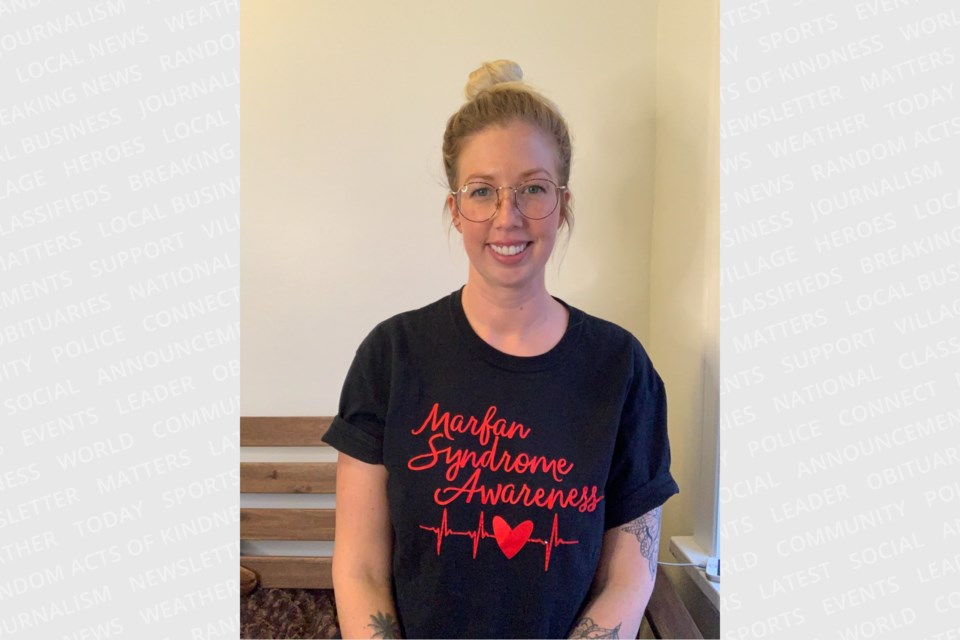A somewhat rare genetic condition that can cause sudden death, Marfan syndrome affects one in 5,000 people, including Guelph's Morgan Story.
Story, who owns Karma Yoga Studio, was diagnosed when she was 27. Now 34, she's in her fourth year of running her annual fundraiser for the syndrome, which primarily affects the body’s connective tissue, and can cause damage to the ligaments, skeletal system, eyes, lungs and heart.
It ranges from mild to severe, and can present itself differently depending on the person. For instance, common physical traits of the syndrome include being abnormally tall, scoliosis, flat feet, needing corrective eyewear, long fingers and toes, and sometimes hypermobility and a concave chest.
The wide spectrum of symptoms and physical traits makes it especially hard to diagnose. This is problematic, because undiagnosed and untreated,the life expectancy of someone with Marfan syndrome is just 30-years-old. Treated, it can be double that.
Though Story wasn’t diagnosed until she was 27, the signs were there throughout her life.
Growing up, Story was constantly afflicted with inexplicable health issues, like random dislocations, tendon tears, chest pain, and scoliosis.
“I would have all these pains of somebody that was like an 80 year old, and they would constantly say, this doesn’t make sense. You didn’t hurt yourself,” she said.
The pain and mysterious injuries continued throughout her life. Then about seven years ago, she sprained her ankle and went to a physiotherapist for help.
She had no mobility in her ankle when she first started, but after only a few sessions, she had extreme mobility in her ankle.
The physiotherapist told Story her tissues were very loose, that it wasn’t normal or safe and she should get tested.
She received her diagnosis not long after, and it was a difficult one to swallow.
Marfan syndrome is caused by a mutation in the FBN1 gene, limiting the body’s ability to make the proteins needed to build connective tissue, making the tissue weaker. The mutation can be inherited, but 25 per cent of those with the syndrome are new mutations, meaning no one in their family has it.
This also causes the tissues in the aorta, the body's main artery, to become weak and inelastic, making it grow in size.
For an average person, the aorta is about 2.2 cm in size; but for someone with Marfan syndrome, it’s typically between four to five cm. Story’s own is 4.5 cm.
The growth and the weakened tissues can cause sudden cardiac death, often from an aortic dissection.
A dissection happens when the inner layer of the aorta is torn. Blood rushes through the tear, which causes the aorta to split, or dissect. If this happens, it can lead to internal bleeding, which is the most common form of death for people with Marfan syndrome.
The disorder will typically get worse over time; and without a cure, the only approach is a preventative one.
For instance, people with the syndrome can take beta blockers and blood pressure medication to slow the growth. They also regularly undergo tests like echocardiograms and MRI’s to monitor their aorta size.
“And then once it reaches a certain size, they go in and replace the aorta with a synthetic cell,” she said.
Strenuous activity increases the risk of aorta growth and dissection, so Story was told she could no longer lift anything over 15 lbs, run, play sports, or have children, since childbirth is one of the leading causes of aortic dissection in women with the syndrome. Even getting up too fast or getting too upset can cause complications.
“I'm a very active physical person, so being told all of a sudden that I basically had to become a vegetable was very upsetting, felt like everything I had known (was) ripped out from underneath me,” she said.
Besides the ongoing pain, one of her biggest hurdles was relearning how to do everything differently, safely.
Still, she said she feels fortunate, as some end up in wheelchairs; others are continuously in and out of the hospital for heart, eye and spinal surgery.
But an earlier diagnosis can help limit complications, especially cardiac-related ones, which is why she wants to raise awareness about the syndrome: Having the diagnosis early in life means you can slow down the aorta growth rate by avoiding strenuous activity, in addition to taking medication.
And the more people who know about it, the more people will get tested in the first place, she said.
“Awareness spreading literally saves lives,” she said.
In the last four years, she has raised between $13,000 to $16,000 with her annual fundraising event. This year she hopes to raise an additional $5,000.
Though the event itself is at capacity, with about 70 tickets sold, she said she is keeping the fundraiser open so those interested can continue to donate.
All proceeds are donated to the Genetic Aortic Disorders Association, or GADA Canada, to advance research and medicine for people living with an aortic disease.
For more resources on Marfan syndrome, visit https://marfan.org.
